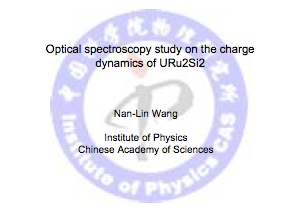Institute of Physics, Chinese Academy of Sciences


Jan 07-09, 2012

Optical spectroscopy study on URu2Si2
Nan-Lin Wang
Institute of Physics, Chinese Academy of Sciences, Beijing 100190, China
In this talk I shall first briefly introduce our experimental setup for optical spectroscopy measurement in IOP. Then I shall present our recent work on a heavy fermion compound URu2Si2. The measurement revealed a systematic evolution of the optical conductivity and spectral weight transfer with temperature and frequencies. Above the coherent temperature, the optical conductivity shows a non-metallic behavior. The Drude component is completely absent. Actually, the conductivity shows a decreasing tendency with decreasing frequency. Clearly, there are no well defined quasiparticles in this temperature range. Furthermore, upon decreasing temperature from 300 K to 70 K, the spectral weight is transferred from the low frequency regime (below 2000 cm-1) to higher frequency region (centered at about 4000 cm-1). Well below the coherent temperature (roughly below 20 K), there appears an abrupt spectral weight suppression below 400 cm-1, yielding evidence for a formation of hybridization gap between conduction electron and narrow f-electron bands. A small part of the suppressed spectral weight was transferred to the low frequency side, leading to a narrow Drude component, while the majority of the suppressed spectral weight was still transferred to the high frequency side centered near 4000 cm-1. This energy scale of the spectral weight transfer is rather high compared to some 4f electron-based heavy fermion systems, for example, CeCoIn5. The small spectral weight of the Drude component is attributed to the heavy quasiparticle effective mass. Below the hidden order phase transition temperature, we observe clearly the opening of a density-wave type energy gap: a large fraction of the coherent Drude spectral weight was removed and piled up just above the energy gap of 270 cm-1 (2/kBTH~5.7), which leads to dramatic reductions of both carrier density and scatter rate.

click the picture to download
contact
Yi-feng Yang, Institute of Physics, Chinese Academy of Sciences, P. O. Box 603, Beijing 100190, China. Tel: (86)-10-82649448, (86)-18911600270; Fax: (86)-10-62553698; Email: yifeng@iphy.ac.cn


